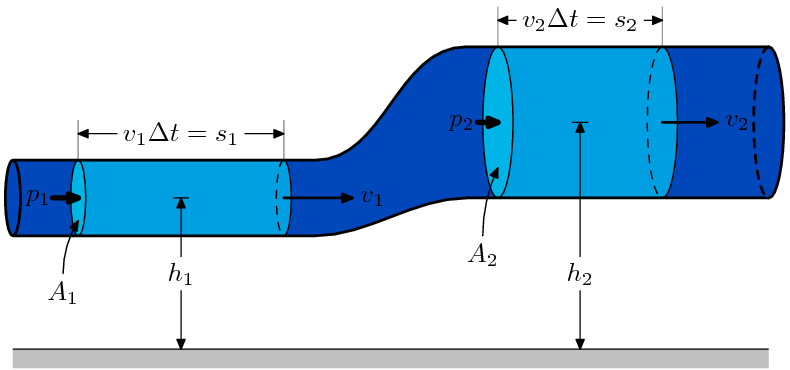See Bernoulli differential equation for an unrelated topic in ordinary differential equations . In fluid dynamics , Bernoulli's equation , derived by Daniel Bernoulli , describes the behavior of a fluid moving along a streamline .
v
2
2
+
g
h
+
p
ρ
=
c
o
n
s
t
a
n
t
{\displaystyle {v^{2} \over 2}+gh+{p \over \rho }=\mathrm {constant} }
v = fluid velocity along the streamlineg = acceleration due to gravity on Earth h = height from an arbitrary point in the direction of gravity p = pressure along the streamline
ρ
{\displaystyle \rho }
density These assumptions must be met for the equation to apply:
Inviscid flow − viscosity (internal friction) = 0Steady flow Incompressible flow −
ρ
{\displaystyle \rho }
enthalpy .)Generally, the equation applies along a streamline. For irrotational flow , it applies throughout the entire flow field. The decrease in pressure simultaneous with an increase in velocity, as predicted by the equation, is often called Bernoulli's principle .
The equation is named for Daniel Bernoulli although it was first presented in the above form by Leonhard Euler .
Derivation
A streamtube of fluid moving to the right. Indicated are pressure, height, velocity, and cross-sectional area. The equation can be derived by integrating the Euler equations , or applying the law of conservation of energy in two sections along a streamline, ignoring viscosity , compressibility, and thermal effects. One has that
the work done by the forces in the fluid + decrease in potential energy = increase in kinetic energy . The work done by the forces is
F
1
s
1
−
F
2
s
2
=
p
1
A
1
v
1
Δ
t
−
p
2
A
2
v
2
Δ
t
.
{\displaystyle F_{1}s_{1}-F_{2}s_{2}=p_{1}A_{1}v_{1}\Delta t-p_{2}A_{2}v_{2}\Delta t.}
The decrease of potential energy is
m
g
h
1
−
m
g
h
2
=
ρ
g
A
1
v
1
Δ
t
h
1
−
ρ
g
A
2
v
2
Δ
t
h
2
{\displaystyle mgh_{1}-mgh_{2}=\rho gA_{1}v_{1}\Delta th_{1}-\rho gA_{2}v_{2}\Delta th_{2}}
The increase in kinetic energy is
1
2
m
v
2
2
−
1
2
m
v
1
2
=
1
2
ρ
A
2
v
2
Δ
t
v
2
2
−
1
2
ρ
A
1
v
1
Δ
t
v
1
2
.
{\displaystyle {\frac {1}{2}}mv_{2}^{2}-{\frac {1}{2}}mv_{1}^{2}={\frac {1}{2}}\rho A_{2}v_{2}\Delta tv_{2}^{2}-{\frac {1}{2}}\rho A_{1}v_{1}\Delta tv_{1}^{2}.}
Putting these together, one gets
p
1
A
1
v
1
Δ
t
−
p
2
A
2
v
2
Δ
t
+
ρ
g
A
1
v
1
Δ
t
h
1
−
ρ
g
A
2
v
2
Δ
t
h
2
=
1
2
ρ
A
2
v
2
Δ
t
v
2
2
−
1
2
ρ
A
1
v
1
Δ
t
v
1
2
{\displaystyle p_{1}A_{1}v_{1}\Delta t-p_{2}A_{2}v_{2}\Delta t+\rho gA_{1}v_{1}\Delta th_{1}-\rho gA_{2}v_{2}\Delta th_{2}={\frac {1}{2}}\rho A_{2}v_{2}\Delta tv_{2}^{2}-{\frac {1}{2}}\rho A_{1}v_{1}\Delta tv_{1}^{2}}
or
ρ
A
1
v
1
Δ
t
v
1
2
2
+
ρ
g
A
1
v
1
Δ
t
h
1
+
p
1
A
1
v
1
Δ
t
=
ρ
A
2
v
2
Δ
t
v
2
2
2
+
ρ
g
A
2
v
2
Δ
t
h
2
+
p
2
A
2
v
2
Δ
t
.
{\displaystyle {\frac {\rho A_{1}v_{1}\Delta tv_{1}^{2}}{2}}+\rho gA_{1}v_{1}\Delta th_{1}+p_{1}A_{1}v_{1}\Delta t={\frac {\rho A_{2}v_{2}\Delta tv_{2}^{2}}{2}}+\rho gA_{2}v_{2}\Delta th_{2}+p_{2}A_{2}v_{2}\Delta t.}
After dividing by
Δ
t
{\displaystyle \Delta t}
ρ
{\displaystyle \rho }
A
1
v
1
{\displaystyle A_{1}v_{1}}
rate of fluid flow =
A
2
v
2
{\displaystyle A_{2}v_{2}}
v
1
2
2
+
g
h
1
+
p
1
ρ
=
v
2
2
2
+
g
h
2
+
p
2
ρ
{\displaystyle {\frac {v_{1}^{2}}{2}}+gh_{1}+{\frac {p_{1}}{\rho }}={\frac {v_{2}^{2}}{2}}+gh_{2}+{\frac {p_{2}}{\rho }}}
or
v
2
2
+
g
h
+
p
ρ
=
C
{\displaystyle {\frac {v^{2}}{2}}+gh+{\frac {p}{\rho }}=C}
g implies
v
2
2
g
+
h
+
p
ρ
g
=
C
.
{\displaystyle {\frac {v^{2}}{2g}}+h+{\frac {p}{\rho g}}=C.}
A free falling mass from a height h (in vacuum ), will reach a velocity
v
=
2
g
h
,
{\displaystyle v={\sqrt {{2g}{h}}},}
h
=
v
2
2
g
{\displaystyle h={\frac {v^{2}}{2g}}}
The term
v
2
2
g
{\displaystyle {\frac {v^{2}}{2g}}}
velocity head .
The hydrostatic pressure or static head is defined as
p
=
ρ
g
h
{\displaystyle p=\rho gh}
h
=
p
ρ
g
{\displaystyle h={\frac {p}{\rho g}}}
The term
p
ρ
g
{\displaystyle {\frac {p}{\rho g}}}
pressure head .
A way to see how this relates to conservation of energy directly is to multiply by density and by unit volume (which is allowed since both are constant) yielding:
v
2
ρ
+
P
=
c
o
n
s
t
a
n
t
{\displaystyle v^{2}\rho +P=constant}
m
V
2
+
P
∗
v
o
l
u
m
e
=
c
o
n
s
t
a
n
t
{\displaystyle mV^{2}+P*volume=constant}






















